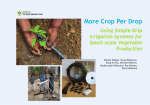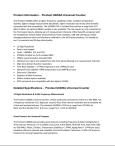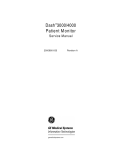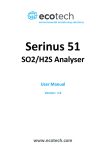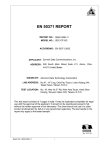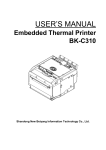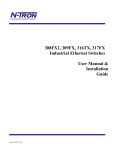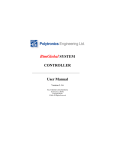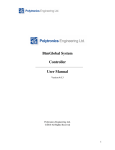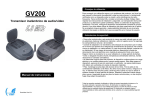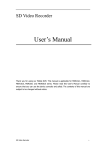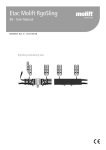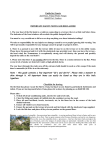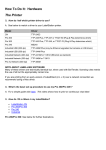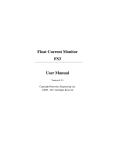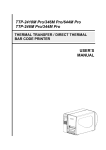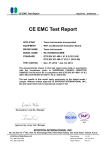Download IEC Certificate
Transcript
Test Report issued under the responsibility of: TEST REPORT IEC 62133, First Edition Secondary cells and batteries containing alkaline or other non-acid electrolytes – Safety requirements for portable sealed secondary cells, and for batteries made from them, for use in portable applications Report Reference No. ..................... : CB120416C20 001 Date of issue..................................... : May 22, 2012 Total number of pages ...................... 32 CB Testing Laboratory................... : Bureau Veritas Consumer Product Services Limited, Taoyuan Branch Address ............................................ : No. 19, Hwa Ya 2nd Rd., Wen Hwa Tsuen, Kwei Shan Hsiang, Taoyuan Hsien 333, Taiwan Applicant’s name ............................ : E-ONE MOLI ENERGY CORP. Address ............................................ : 10, Dali 2nd Rd., Tainan Science-Based Industrial Park, Shanhua Dist., Tainan County, 74144, Taiwan Test specification: Standard ........................................... : IEC 62133: 2002 (1st Edition) Test procedure ................................. : CB/CCA Non-standard test method…………..: N/A Test Report Form No...................... : IEC62133A Test Report Form(s) Originator ........ : UL International Demko A/S Master TRF ...................................... : Dated 2008-02 Copyright © 2008 IEC System for Conformity Testing and Certification of Electrical Equipment (IECEE), Geneva, Switzerland. All rights reserved. This publication may be reproduced in whole or in part for non-commercial purposes as long as the IECEE is acknowledged as copyright owner and source of the material. IECEE takes no responsibility for and will not assume liability for damages resulting from the reader's interpretation of the reproduced material due to its placement and context. If this Test Report Form is used by non-IECEE members, the IECEE/IEC logo and the reference to the CB Scheme procedure shall be removed. This report is not valid as a CB Test Report unless signed by an approved CB Testing Laboratory and appended to a CB Test Certificate issued by an NCB in accordance with IECEE 02. Test item description .....................: Rechargeable Lithium-Ion Battery Trade Mark ....................................... : Molicel or Manufacturer .................................... : SOLE ENERGY TECH(ZJGFTZ) CO., LTD. Model/Type reference....................... : MCR-1821J/1-H (2ICR19/66) Ratings ............................................. : 7.4Vdc, 2.4Ah Page 3 of 32 Report No. CB120416C20 001 Summary of testing: Tests performed (name of test and test clause): Testing location: 4.2.2 Vibration Bureau Veritas Consumer Product Services Limited, Taoyuan Branch 4.2.4 Temperature cycling nd 4.3.2 External short circuit 4.3.3 Free fall 4.3.4 Mechanical shock (crash hazard) The load conditions used during testing: The unit is charging the empty battery pack and discharging the full charged battery pack according to its rating. Note: (1) Unless otherwise stated, the charging procedure for test purposes is carried out in an ambient temperature of 20±5°C, using the method declared by the manufacturer. (2) Prior to charging, the battery shall have been discharged at 20±5°C at a constant current of 0.2 It A down to a specified final voltage. Summary of compliance with National Differences: None TRF No.: IEC62133A No. 19, Hwa Ya 2 Rd., Wen Hwa Tsuen, Kwei Shan Hsiang, Taoyuan Hsien 333, Taiwan Page 4 of 32 Copy of marking plate Explanation of the date Code: TRF No.: IEC62133A Report No. CB120416C20 001 Page 5 of 32 Report No. CB120416C20 001 Test item particulars .................................................. : Classification of installation and use ............................ : Built-in, equipment is for ITE product use Supply Connection........................................................ : Customized connector ...................................................................................... : ...................................................................................... : Possible test case verdicts: - test case does not apply to the test object.................. : N/A - test object does meet the requirement ....................... : P (Pass) - test object does not meet the requirement ................. : F (Fail) Testing .......................................................................... : Date of receipt of test item ............................................ : April 18, 2012 Date (s) of performance of tests ................................... : April 18, 2012 – May 08, 2012 General remarks: The test results presented in this report relate only to the object tested. This report shall not be reproduced, except in full, without the written approval of the Issuing testing laboratory. “(see Enclosure #)” refers to additional information appended to the report. “(see appended table)" refers to a table appended to the report. Throughout this report a point is used as the decimal separator. General product information: 1) The equipment under test (EUT) model MCR-1821J/1-H (2ICR19/66) is a Rechargeable Lithium-Ion Battery. 2) The maximum ambient temperature is specified as 45 °C for Charging and 60 °C for Discharging. 3) Dimension of the Lithium ion polymer rechargeable battery: (T) 20.6mm by (W) 39.0mm by (L) 71.0mm. 4) Weight: Below 150g. Test condition: Temperature: 20±5°C Relative humidity: 60% Air pressure: 950 mbar The test samples were pre-production samples without serial number. TRF No.: IEC62133A Page 6 of 32 Report No.: CB120416C20 001 IEC 62133 Clause Requirement + Test 1 General Parameter measurement tolerances 2 Result - Remark P Both normal and foreseeable misuses are evaluated in the report. All control and measure values were within the tolerances. The battery is safe and continues to function in all respects under the condition of intended use. Cells and batteries subject to reasonably foreseeable The battery is safe and do not misuse do not present significant hazards. present significant hazards under the condition of reasonably foreseeable misuse. 2.1 P P General Safety Considerations Cells and batteries subject to intended use be safe and continue to function in all respects Verdict Insulation and Wiring See below –Insulation Resistance between an accessible metal case (excluding electrical contacts) and positive terminals ≥ 5MΩ. No accessible metal case. Internal wiring and insulation are sufficient to withstand maximum anticipated current, voltage and temperature requirements For current: The internal wiring cable dimension had been verified to comply with the Clause 3.1.1 of IEC 60950-1. P P P N/A P For voltage: See List of critical components table. For temperature: Evaluated with temperature test in Clause 4.2.4. 2.2 Orientation of wiring maintains adequate creepage and clearance distances between conductors. Mechanical integrity of internal connections are sufficient to accommodate conditions of reasonably foreseeable misuse. The internal connections were considered as sufficient to accommodate conditions of reasonably foreseeable misuse. P Venting See below. P Battery cases and cells incorporate a pressure relief mechanism or are constructed so that they relieve excessive internal pressure at a value and rate that will preclude rupture, explosion and self-ignition. The edge of packing which next to the terminals was considered as the pressure relief mechanism, which can release the pressure during the abnormal operation. P Encapsulant used to support cells within an outer casing does not cause the battery to overheat during normal operation no inhibit pressure relief. The battery is a built in product, which shall be enclosed in a rigid case, and will be evaluated in the final system. N/A TRF No.: IEC62133A Page 7 of 32 Report No.: CB120416C20 001 IEC 62133 Clause Requirement + Test Result - Remark 2.3 Temperature/current management See below. P The batteries are designed such that abnormal temperature rise conditions are prevented. Protected by limiter in the certified cell and by components (U1, Q1, F1 and F2) in the battery pack circuit. P Means is provided to limit current to safe levels during charge and discharge. Protected by limiter in the certified cell and by components (U1, Q1, F1 and F2) in the battery pack circuit. P Terminal contacts See below. P Terminals have a clear polarity marking on the external surface of the battery Customized connector used and the polarity marking was provided on the marking plate. P 2.4 2.5 The size and shape of the terminal contacts ensure The cross section area of wires that they can carry the maximum anticipated current. and connector are considered enough to carry the rating current of the battery. P External terminal contact surfaces are formed from conductive materials with good mechanical strength and corrosion resistance. The connector provides good mechanical strength to the copper alloy terminal. P Terminal contacts are arranged to minimize the risk of short circuits. The connector designation to prevent short circuit. Proper spacing and insulation were maintained to prevent shortcircuit. P Assembly of cells into batteries See below. P Cells used in the battery assembly have closely Two cells in serial are totally matched capacities, are of the same design, and are identical. of the same chemistry and same manufacturer. The battery incorporates separate circuitry to prevent The battery does not have the cell reversal from uneven charges as the pack is selective discharge function. designed for the selective discharge of a portion of its series connected cells. 2.6 The manufacturer’s procedures for the inspection of materials, components and cells which covers the process of producing each type of battery and comply with the requirement. TRF No.: IEC62133A N/A P P Type Test Conditions Tests were conducted with the number of cells or batteries as outlined in Table 1 of IEC 62133 with cells or batteries that were not more than 3 months old. P P Quality Plan The manufacture has prepared a quality plan defining the procedures for the inspection of materials, components, cells and batteries and which covers the process of producing each type of cell and battery. 3 Verdict The batteries under testing were less than 3 months old. P Page 8 of 32 Report No.: CB120416C20 001 IEC 62133 Clause Requirement + Test Result - Remark Unless noted otherwise in the test methods, testing was conducted in an ambient of 20°C ± 5°C. The testing was conducted at the ambient range of 20°C 25°C. Verdict P P 4 Specific requirements and tests 4.1 Charging procedure for test purposes The battery was charged in the ambient temperature according to manufacturer’s spec. P 4.2 Intended Use See below. P 4.2.1 Continuous Low Rate Charge See below. N/A Fully charged cells are subjected for 28 days to a charge as specified by the manufacturer. Certified battery cell used. N/A Nickel systems: no fire, no explosion This is not a nickel system. N/A Lithium systems: no fire, no explosion, no leakage Certified battery cell used. N/A Vibration See below. P The measured open circuit voltage of the fully charged cells or batteries is within anticipated parameters Five batteries were fully charged according to clause 4.1 P The cells or batteries are subjected to a vibration sequence as outlined in Table 2 of IEC 62133 with amplitude of 0.75 mm and a total maximum excursion of 1.52 mm. The frequency was varied at the rate of 1 Hz/min between the limits of 10 Hz and 55 Hz. The entire range of frequencies (10 Hz to 55 Hz) and return (55 Hz to 10 Hz) was traversed in 90 min ± 5 min for each mounting position. Considered for the test. P The vibration was applied in each of three mutually perpendicular directions. Considered for the test. P Results: no fire, no explosion, no leakage No fire, no explosion, no leakage during and after the vibration test. P 4.2.2 (See Table 4.2.2.) 4.2.3 Moulded case stress at high ambient temperature See below. P Fully charged batteries were placed in an aircirculating oven at a temperature of 70°C ± 2°C for 7 hours. Afterwards, they are removed and allowed to return to room temperature. Three batteries were fully charged and tested for these conditions. P Results: no physical distortion of the battery casing resulting in exposure if internal components. No physical distortion of battery case. TRF No.: IEC62133A The used test sample’s no.: No. P006 to P008 P Page 9 of 32 Report No.: CB120416C20 001 IEC 62133 Clause Requirement + Test Result - Remark 4.2.4 Temperature cycling See below. P Fully charged cells or batteries were subjected to temperature cycling (-20C, +75C) in forced draught chambers according to the procedure outlined in 4.2.4 b) and Fig. 1 of IEC 62133. Five batteries were fully charged and tested for these conditions. P After the fifth cycle, the cells or batteries were stored for 7 days prior to examination. Considered. P Results: No fire, no explosion, no leakage No fire, no explosion, no leakage after the test. P 4.3 Reasonably foreseeable misuse 4.3.1 Incorrect installation of a cell (nickel systems only) 4.3.2 Verdict The used test sample’s no.: No. P009 to P013 P Lithium system cell used. N/A Four fully charged cells of the same brand, type, size Lithium system cell used. and age were connected in series with one of the four cells reversed. The assembly was connected across a 1-ohm resistor until the vent opens or until the temperature of the reversed cell returns to ambient temperature. N/A Alternatively, a stabilized dc power supply was used t Lithium system cell used. simulate the conditions imposed on the reversed cell. N/A Results: no fire, no explosion Lithium system cell used. N/A External short circuit See below. P Fully charged cells or batteries were subjected to a short circuit test at 20°C ± 5°C. Five batteries were fully charged and tested for this condition. P The testing was conducted at 23.5 °C Fully charged cells or batteries were subjected to a short circuit test at 55°C ± 5°C. Five batteries were fully charged and tested for this condition. P The testing was conducted at 55.6 °C. The external resistance is measured 10 mΩ maximum. P The cells or batteries were tested for 24 h or until the The batteries were tested for case temperature declined by 20% of the maximum 24 hours. temperature rise. P Results: no fire, no explosion. P The external resistance did not exceed 100 mΩ. No fire, no explosion after the test. See Table 4.3.2. TRF No.: IEC62133A Page 10 of 32 Report No.: CB120416C20 001 IEC 62133 Clause Requirement + Test Result - Remark 4.3.3 Free fall See below. Fully charged cells or batteries were dropped 3 times Three batteries were fully from a height of 1.0 m onto a concrete floor. charged and tested for this condition. Verdict P P The used test sample’s no.: No. P024 to P026 4.3.4 Results: no fire, no explosion No fire, no explosion after the test. P Mechanical shock (crash hazard) See below. P Fully charged cells or batteries were subjected to a total of three shocks of equal magnitude applied in each of three mutually perpendicular directions. At least on of the directions was perpendicular to a flat face. During the initial 3 milliseconds, the minimum average acceleration was 75 gn. The peak acceleration was between 125 gn and 175 gn. Five batteries were fully charged and tested for this condition. Refer to the photos and test charts for detail. P Remark: (1) The used test sample’s no.: No. P027 to P031. (2) The EUTs were subjected to a total of three shocks of equal magnitude applied in each of three mutually perpendicular directions. (3) As there are two senses per direction, each sample will be submitted to a total of six shock impulses. 4.3.5 4.3.6 Results: no fire, no explosion, no leakage No fire, no explosion, no leakage after the test. Thermal abuse See below. N/A Fully charged cells were placed in a gravity or circulating air-convention oven. The oven temperature was raised at a rate of 5°C/min ± 2°C/min to a temperature of 130°C ± 2°C. The cell remained at that temperature for 10 minutes before the test was discontinued. Certified battery cell used. N/A Results: no fire, no explosion Certified battery cell used. N/A Crushing of cells See below. N/A Fully charged cells were crushed between two flat surfaces with a hydraulic ram exerting a force of 13 kN ± 1 kN. Certified battery cell used. N/A A cylindrical or prismatic cell was crushed with its longitudinal axis parallel to the flat surfaces of the crushing apparatus. Certified battery cell used. N/A A second set of prismatic cells was tested, rotated 90 Certified battery cell used. degrees around their longitudinal axis compared to the first set. N/A Results: no fire, no explosion. N/A TRF No.: IEC62133A Certified battery cell used. P Page 11 of 32 Report No.: CB120416C20 001 IEC 62133 Clause Requirement + Test Result - Remark 4.3.7 Low pressure See below. N/A Fully charged cells are placed in a vacuum chamber whose internal pressure was gradually reduced to a pressure equal to or less than 11.6 kPa and held at that value for 6 hours. Certified battery cell used. N/A Results: no fire, no explosion, no leakage Certified battery cell used. N/A Overcharge for nickel systems This is not a nickel system. N/A A discharged cell or battery was subjected to a high- This is not a nickel system. rate charge of 2.5 times the recommended charging current for a time that produced a 250% charge input (250% of rated capacity). N/A Results: no fire, no explosion. This is not a nickel system. N/A Overcharge for lithium systems See below. N/A A discharged cell was charged from a power supply of ≥ 10 V, at a charging current Irec recommended by the manufacturer for 2.5 C5/Irec hours.. Certified battery cell used. N/A Results: no fire, no explosion. Certified battery cell used. N/A Forced discharge See below. N/A Discharged cells intended for use in multi-cell applications, were subjected to a reverse charge 1t 1.0 It (A) for 90 minutes. Certified battery cell used. N/A Results: no fire, no explosion Certified battery cell used. N/A Cell protection against a high charging rate (lithium systems only) See below. N/A Discharged cells were charged at three times the charging current recommended by the manufacturer until the cells was fully charged or an internal safety devices cut off the charge current before the cell became fully charged. Certified battery cell used. N/A Results: no fire, no explosion Certified battery cell used. N/A Information for safety See below. P Information is provided to equipment manufacturers in the form of instructions to minimize and mitigate hazards associated with the cells or batteries in accordance with guidelines outlined in informative Annex A. Provided in the product specification, which will considered during the end product investigation. P Information is provided to end-users in the form of instructions to minimize and mitigate hazards associated with the batteries in accordance with guidelines outlined in informative Annex B. Provided in the product specification, which will be merged into the user manual of the end product. P 4.3.8 4.3.9 4.3.10 4.3.11 5 TRF No.: IEC62133A Verdict Page 12 of 32 Report No.: CB120416C20 001 IEC 62133 Clause Requirement + Test 6 Marking 6.1 Cell Marking See below. N/A Nickel system cells are marked in accordance with IEC 61951-1, -2, IEC 61440, or IEC 61436 as applicable. See Copy of Marking Plate item in the beginning of this report. This is not a nickel system. N/A Lithium system cells are marked in accordance with IEC 61960. See Copy of Marking Plate item in the beginning of this report. The product is Lithium-ion battery. N/A Battery Marking See below. Batteries of nickel systems are marked in accordance with IEC 61951, or IEC 61951 -2 as applicable. See Copy of Marking Plate item in the beginning of this report This is not a nickel system. 6.2 6.3 7 Result - Remark Verdict P N/A Batteries of lithium system are marked in accordance See copy of the marking plate. with IEC 61960. See Copy of Marking Plate item in the beginning of this report. P Batteries are marked with the cautionary marks. See copy of the marking plate. P Other Information See below. P Disposal instructions are marked on the battery or The disposal instructions are supplied in the information packaged with the battery. provided in the specification. P Recommended charging instruction are marked on the battery or supplied in the information packaged with the battery. The recommended charging instructions are provided in the specification. P The package method had been Indicated in the product specification, which had been passed the environmental test to ensure the well packaging method and to prevent the unintentional electrical conduction. P Packaging Cells or batteries were provided with packaging that was adequate to avoid mechanical damage during transport, handling and stacking. The materials and pack design was chosen to prevent the development of unintentional electrical conduction, corrosion of the terminal and ingress of moisture. TRF No.: IEC62133A Page 13 of 32 Report No.: CB120416C20 001 IEC 62133 Clause Requirement + Test Result - Remark 2.1 – 2.5 TABLE: List of critical Components Type/Model Verdict P Object/part No. Manufacturer/ trademark Technical Data Standard Marks of Conformity Battery Cell (2S) E-ONE MOLI ENERGY CORP. ICR18650J 3.7Vdc, 2370mAh, Lithium-Ion type IEC 62133: 2002, UL 1642 CB (Ref Certificate No.: Fr607332/A1), UL PCB Various Various V-1 min., 105°C min. UL 796 UL Fuse (F1) Tamura Thermal T6D Device Corporation 50Vdc, 9A, 139°C EN 60691: VDE (Ref 2003+A1:2007 Certificate No.: 40009915) Fuse (F2) Polytronics SMFS1206P500 32Vdc, 5A technology Corp UL 248-1 UL (E331807) - Alternate use Littelfuse Inc F1206HI5000V0 32Vdc, 5A 32TM UL 248-1 UL (E232989) Protection IC (U1) Seiko Instruments Inc. S-8242B -- -- Tested in the appliance MOSFET (Q1) International Rectifier IRF7313PbF -- -- Tested in the appliance Supplementary information: N/A TABLE: 4.2.1 Continuous Low Rate Charge Test Model Recommended Charging Method, CC, CV, or CC/CV -- -- Recommended Recommended OCV at Start Charging Voltage Charging Current of Test, Vdc Vc, Vdc Irec, A -- -- -- Results -- Supplementary information: P TABLE: 4.2.2 – Vibration Test Model OCV at Start of Test, Vdc Results MCR-1821J/1-H (Sample no.: P001) 8.41 at X / Y / Z axis No fire, no explosion, no leakage MCR-1821J/1-H (Sample no.: P002) 8.42 at X / Y / Z axis No fire, no explosion, no leakage MCR-1821J/1-H (Sample no.: P003) 8.41 at X / Y / Z axis No fire, no explosion, no leakage MCR-1821J/1-H (Sample no.: P004) 8.42 at X / Y / Z axis No fire, no explosion, no leakage MCR-1821J/1-H (Sample no.: P005) 8.42 at X / Y / Z axis No fire, no explosion, no leakage Supplementary information: - No fire or explosion - No leakage TRF No.: IEC62133A Page 14 of 32 Report No.: CB120416C20 001 IEC 62133 Clause Requirement + Test Result - Remark Verdict N/A TABLE: 4.3.1 – Incorrect Installation of a Cell Test (Nickel Systems) Model OCV (reversed cell), Vdc Results -- -- -- Supplementary information: Li-polymer cell used. P TABLE: 4.3.2 – External Short Circuit Test Model Ambient (At 20°C ± 5ºC or 55°C ± 5°C) OCV at start of test, Vdc Resistance Maximum Case of Circuit, Temperature Ω Rise ∆T, °C Results MCR-1821J/1-H (Sample no.: P014) 23.5 8.42 0.01 0.6 No fire, no explosion MCR-1821J/1-H (Sample no.: P015) 23.5 8.43 0.01 0.5 No fire, no explosion MCR-1821J/1-H (Sample no.: P016) 23.5 8.42 0.01 0.5 No fire, no explosion MCR-1821J/1-H (Sample no.: P017) 23.5 8.41 0.01 0.6 No fire, no explosion MCR-1821J/1-H (Sample no.: P018) 23.5 8.42 0.01 0.6 No fire, no explosion MCR-1821J/1-H (Sample no.: P019) 55.6 8.41 0.01 1.4 No fire, no explosion MCR-1821J/1-H (Sample no.: P020) 55.6 8.42 0.01 1.3 No fire, no explosion MCR-1821J/1-H (Sample no.: P021) 55.6 8.41 0.01 1.5 No fire, no explosion MCR-1821J/1-H (Sample no.: P022) 55.6 8.40 0.01 1.5 No fire, no explosion MCR-1821J/1-H (Sample no.: P023) 55.6 8.41 0.01 1.4 No fire, no explosion Supplementary information: - No fire or explosion N/A TABLE: 4.3.8 – Overcharge Test (Nickel Systems) Model OCV prior to charging, Vdc Maximum Charge Current, A Time for Charging, h Results -- -- -- -- -- Supplementary information: Li-polymer cell used. TRF No.: IEC62133A Page 15 of 32 Report No.: CB120416C20 001 IEC 62133 Clause Requirement + Test Result - Remark Verdict N/A TABLE: 4.3.9 – Overcharge Tests (Lithium Systems) Model OCV at start of test, Vdc Maximum Charging Current, mA Maximum Charging Voltage, Vdc Total Time of Charging, h Results -- -- -- -- -- -- Supplementary information: N/A TABLE: 4.3.10 – Forced Discharge Test Model OCV before application of reverse charge, Vdc Measured Reverse Charge It, A Total Time for Reversed Charge Application, Min Results -- -- -- -- -- Supplementary information: N/A TABLE: 4.3.11 – Cell Protection Against a High Charging Rate Test (Lithium Systems) Model OCV at start of test, Vdc Maximum Charging Current, mA Maximum Charging Voltage, Vdc Results -- -- -- -- -- Supplementary information: TRF No.: IEC62133A Page 16 of 32 Report No. CB120416C20 001 List of test equipment used: (Note: This is an example of the required attachment. Other forms with a different layout but containing similar information are also acceptable.) Clause Measurement / testing See next page TRF No.: IEC62133A Testing / measuring equipment / material used Range used Calibration date Page 17 of 32 TRF No.: IEC62133A Report No. CB120416C20 001 Page 18 of 32 TRF No.: IEC62133A Report No. CB120416C20 001 Page 19 of 32 TRF No.: IEC62133A Report No. CB120416C20 001 Page 20 of 32 Report No. CB120416C20 001 MAXIMUM UNCERTAINTIES OF MEASUREMENTS This table indicates the maximum values of uncertainties associated with the tests being able to be present in this document. Type of measurement Generic measure of electrical value by direct reading of digital instrument) Voltage (V) Current (A) Power (W) Resistance (Ohms) Generic measure of time Generic measure of length value Generic measure of weight value Continuous low-rate charging (Voltage, Current, Time) Vibration (Voltage, Current, Time) Moulded case stress at high ambient temperature (Voltage, Current, Time) Temperature cycling (Voltage, Current, Time) Incorrect installation of a cell (nickel systems only) (Voltage, Current, Temperature, Time, Capacity) External short circuit (Temperature, Time, Capacity) Free fall (Voltage, Current, Dimension) Mechanical shock (crash hazard) (Voltage, Current, Temperature, Time) Thermal abuse (Voltage, Current, Temperature, Time) Crushing of cells (Voltage, Current) Low pressure (Voltage, Current, Temperature, Time, Dimension) Overcharge for nickel systems (Voltage, Current, Time) Overcharge for lithium systems (Voltage, Current, Time) Forced discharge (Voltage, Current, Time) Cell protection against a high charging rate (lithium systems only) (Voltage, Current) TRF No.: IEC62133A Uncertainty of measurement (k=2) (V) meter accuracy 0.1% (A) meter accuracy 0.5% (W) meter accuracy 1.0% (Ohms) meter accuracy 1.5% +/- 0.38 Second caliper (0-200mm): +/-0.15 mm tape measure (0-500cm): +/-1.4 mm scale (0-600g): +/- 0.55 g balance (0-150kg): +/- 15.95 g +/- 0.276% +/- 3% +/- 0.6% +/- 0.6% +/- 0.74% +/- 0.8% +/- 0.11% +/- 11.8% +/- 0.738% +/- 0.216% +/- 5.013% +/- 0.50% +/- 0.22% +/- 0.52% +/- 0.24% Page 21 of 32 Top view for the battery Bottom view for the battery TRF No.: IEC62133A Report No. CB120416C20 001 Page 22 of 32 The view for the soft pack and enclosure Top view of soft pack TRF No.: IEC62133A Report No. CB120416C20 001 Page 23 of 32 Bottom view of soft pack The view of PCB TRF No.: IEC62133A Report No. CB120416C20 001 Page 24 of 32 Vibration test condition-1 (X axis direction) Vibration test condition-2 (Y axis direction) TRF No.: IEC62133A Report No. CB120416C20 001 Page 25 of 32 Vibration test condition-3 (Z axis direction) Shock test condition-1 (X axis direction) TRF No.: IEC62133A Report No. CB120416C20 001 Page 26 of 32 Shock test condition-2 (Y axis direction) Shock test condition-3 (X axis direction) TRF No.: IEC62133A Report No. CB120416C20 001 Page 27 of 32 Vibration test chart-X axis direction TRF No.: IEC62133A Report No. CB120416C20 001 Page 28 of 32 Vibration test chart-Y axis direction TRF No.: IEC62133A Report No. CB120416C20 001 Page 29 of 32 Vibration test chart-Z axis direction TRF No.: IEC62133A Report No. CB120416C20 001 Page 30 of 32 Shock test chart-X axis direction TRF No.: IEC62133A Report No. CB120416C20 001 Page 31 of 32 Shock test chart-Y axis direction TRF No.: IEC62133A Report No. CB120416C20 001 Page 32 of 32 Shock test chart-Z axis direction TRF No.: IEC62133A Report No. CB120416C20 001

































